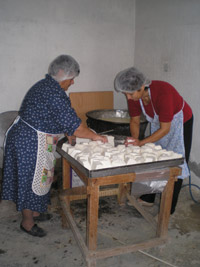Halitz̆ia from Tillyria is a soft cheese, white in colour, with holes and a sour taste.
Name - Origin
Halitz̆ia are produced from fresh sheep's or goat's milk, or a combination of these, in the region of Tillyria, a mountainous peninsula of Cyprus in the north-western part of the island between the Gulf of Chrysochous and the Gulf of Morphou, and in Tsakkistra, a community of the Nicosia district,.
Chrysanthos St. Kyprianou, in his publication "Some Cypriot food of the village of Tsakkistra", notes that the farmers would use the milk produced during the summer months, when the sheep were grazing on the remains of the harvest (Kyprianou 1970).
Sotiris Economides, in his «Το γάλα και τα γαλακτοκομικά προϊόντα της Κύπρου με ιδιαίτερη αναφορά στο τυρί χαλλούμι» (milk and dairy products of Cyprus with special reference to halloumi cheese), notes after the curd was prepared, it was squeezed in talarka (s. talarin = woven basket , pl. talarka) so that the whey could be drained off. Then, it was removed from the talarin and cut it into slices (about 2cm thick), and salted before placed in a basin to cool. On the following day, the pieces were placed in a container with salted whey, where the halitz̆ia could be stored for up to a year (Economides 2004, 90).
ETYM. < halîc [large bag (dialect) = clay dish used by peasants (Yangoullis 2014, entry χαλίτσ̆α,τα) / The word halitz̆ia is derived from the word haliki (gravel). Therefore, it is likely that they were so named because they resemble in shape to pebbles and gravel (Note: Stalo Lazarou).
Immediately after milking, raw milk is filtered through a fine and densely woven cheesecloth, than rennet is added and the milk is left to stand for about 1 hour to curdle. The curd is placed in a talarka and pressed lightly by hand. It is then removed and cut into four pieces, salted and placed in noro (whey) without removing the anari (the leftover of noros is used to make anari). At low temperatures, it takes up to 40 days for the cheese to mature, whereas at high temperatures it takes less time. Halitz̆ia Tillyrias are stored in noro brine for several months.
Functional and symbolic role
Halitz̆ia are consumed either in a salad cut in pieces, or with bread, or on their own when drizzled with olive oil and sprinkled with oregano.
Additional information and bibliography
According to the local producers of Tillyria, the know-how for producing halitz̆ia has been passed down from generation to
generation until today.
Yangoullis K. G. (2014), Θησαυρός Κυπριακής Διαλέκτου. Ερμηνευτικό, Ετυμολογικό, Φρασεολογικό και Ονοματολογικό Λεξικό της Μεσαιωνικής και Νεότερης Κυπριακής Διαλέκτου, Βιβλιοθήκη Κυπρίων Λαϊκών Ποιητών, 74, Theopress Publications, Nicosia.
Kyprianou X. St. (1970), Μερικές κυπριακές τροφές του χωριού Τσακκίστρα, Publications of Lapithos High School, Lapithos.
Economides S. (2004), Το γάλα και τα γαλακτοκομικά προϊόντα της Κύπρου με ιδιαίτερη αναφορά στο τυρί χαλλούμι, Cyprus Dairy Industry Organisation, Nicosia.
Ministry of Agriculture, Natural Resources and Environment, Department of Agriculture (2010), Gastronomic Map of Cyprus, Press and Information Office (G.T.P. 379/2010-2.000), Nicosia.
Stalo Lazarou, Demetra Demetriou, Antonia Matala, Eleni Christou, Argyro Xenophontos.
